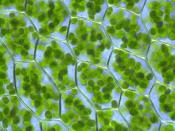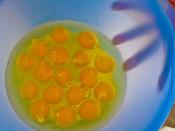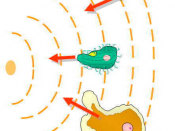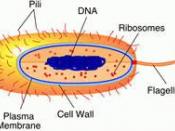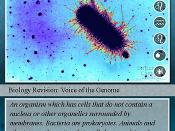The endosymbiotic theory explains the evolution of the eukaryotic cell and eukaryotic organelles by phagocytocis of small prokaryotic cells. This theory states that some of the organelles in today's eukaryotic cells were once prokaryotic bacteria.
In this theory, the first eukaryotic cell was probably an amoeba-like nucleated (probably DNA in a nucleoid region not an actual nucleus) prokaryotic cell that got nutrients by phagocytosis (engulfing nutrients or other cells) Some of these unicellular amoeba-like organisms engulfed prokaryotic cells that somehow were not digested within the organism. In the process of being engulfed the smaller cells would have been wrapped in membrane from the larger cell, today we see double membranes in mitochondria and chloroplasts. The symbiotic relationship was beneficial because the host cell would have provided essential nutrients to the engulfed prokaryotic cell in exchange the smaller prokaryotic cell used these nutrients to synthesize ATP molecules, this ATP was used as an energy source by the host cell.
The smaller prokaryotic cell was given a safe environment as well as receiving nutrients from the larger host cell.
The small prokaryotic cell developed a symbiotic (mutually beneficial) relationship with the host cell. This smaller prokaryotic cell would eventually become mitochondria or chloroplasts. Mitochondria would have been formed when bacteria capable of aerobic respiration were ingested by a much larger cell. Chloroplasts formed when photosynthetic bacteria were ingested. They eventually lost their cell wall and much of their DNA because they were not of benefit within the host cell. Mitochondria and chloroplasts cannot grow outside their host cell in normal conditions because they now depend on the cell for protection and nutrients. The reason we do not see this type of symbiotic relationship today is because conditions are much different now then they were on earth millions of years ago when this symbiotic event first took place.
Scientists can support the endosymbiotic hypothesis because the characteristics of energy organelles are so similar to those of prokaryotes. Energy organelles have their own set of genetic information it is not found enclosed in a nucleus but a circular ring in a nucleoid region just like prokaryotic DNA. Mitochondria and chloroplasts have their own ribosomes this would imply that at one time energy organelles were able be self sufficient. Both organelles have a double membrane, a remnant of ancient endosymbiotic event. Also when a cell divides by mitosis the energy organelles replicate the same way as do prokaryotic bacteria, by binary fission. Mitochondria and chloroplasts are about the same size as prokaryotic cells. The DNA of these energy organelles is different from the DNA found in the cells nucleus. There is some evidence of bacterial DNA in these energy organelles that suggests that long ago they were once prokaryotic cells.
Biology, Neil A. Campbell & Jane B. ReeceBenjamin Cummings; 7th Edition, 2006Investigating Biology, Neil A Campbell & Jane B.ReeceBenjamin Cummings; 6th Edition 2007
